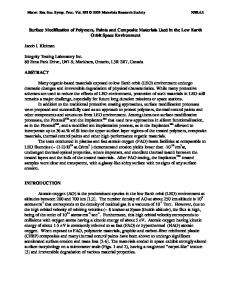Surface and Interface Modification of Polymers
- PDF / 2,602,314 Bytes
- 5 Pages / 576 x 777.6 pts Page_size
- 49 Downloads / 357 Views
plications requiring nonstick, passive surfaces. Surface and Interfacial Energies The structure and properties of polymers at interfaces1 are unique among materials due to their long-chain nature and to their intrinsically low density. The low density of polymers is related to their elemental composition consisting primarily of low-mass elements such as carbon, hydrogen, oxygen, and occasionally nitrogen, silicon, and sulfur. Polymers consequently have relatively low surface energies since surface tension is proportional to density raised to the fourth power.2 (The power-law coef-
ficient lies within the range of 3-4 for polymers.3) The influence of chemical structure is evidenced by the dependence of polymer surface tension on the square of the solubility parameter.4 Lowpolarity polymers, such as polyethylene, polypropylene, poly(tetrafluoroethylene) molecules, and poly(siloxane) molecules have commensurably low surface energies (15-20 dyne/cm). More polar polymers, such as some polyesters and polyamides,3 may have surface tensions as high as 45 dynes/cm. Surface tensions of polymeric fluids may be measured by a variety of direct techniques, with those based upon analysis of the shape of axisymmetricfluid drop profiles 135 being the most versatile and popular. The interfacial tension between two immiscible-fluid polymer phases may also be directly measured with these techniques 6 and generally falls within the range of 0.5-10 dynes/cm. 1 ' 3 Polymer melt surface tensions and interfacial tension between immiscible homopolymer melts9 scale inversely with the numberaverage molecular weight for high molecular weights and can be tailored by modifying the end group, as illustrated in Figure 1 for a,a>-terminated poly(dimethylsiloxane) molecules. At intermediate molecular weights, an inverse two-thirds power-law dependence on molecular weight has been observed.1'3 The surface tension of a solid polymer or
Wetting Wetting of any substrate is governed by the Young equation, which relates the equilibrium contact angle of the wetting component on the substrate 6 to the appropriate interfacial tensions, y LV cos
(1)
The term ysv is the interfacial tension of the solid material in equilibrium with a fluid vapor, yLV is the surface tension of the fluid material in equilibrium with its vapor, and ySi. is the interfacial tension between the solid and liquid materials. Complete, spontaneous wetting occurs when 0 — 0°, or when ysy — ysL + TLVWetting is favored when the substrate surface tension ysv is high and the surface tension of the wetting fluid yLV is low. Low-energy polymers therefore easily wet high-energy substrates such as metals. Conversely, polymeric coatings and polymeric substrates with low surface energies will not be readily wet by other materials and are useful for ap-
MRS BULLETIN/JANUARY 1996
X Methyl PDMS OAminePDMS BHydroxy PDMS Carboxy PDMS
0.0005
0.001
0.0015
0.002
0.0025
Figure 1, Surface tension as a function of inverse number-average molecular weight for a,
Data Loading...











